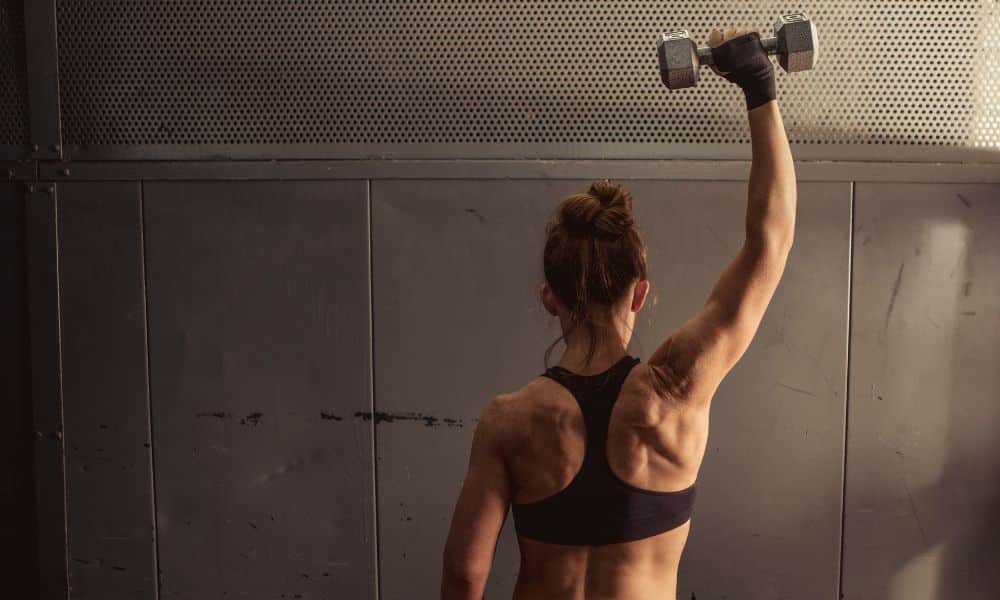Many people think the chest fly is useless for building big pecs, but it can be an effective isolation exercise to develop your chest muscles. Some say you need to do more than just bench presses and push-ups to see results, and this is true.
We are not saying these two exercises are wrong; they’re great compound exercises. But if you want those excellent cuts in your pectoral muscles, supplementing with some isolation work will help get you there. But, again, finding the proper movement for you is vital because everyone has a different muscle size and definition.
This isolation exercise is for you if you want to sculpt a broad chest and increase your definition.
It’s simple, and you can do it in less than 10 minutes! This article will give you the necessary knowledge to increase your body’s muscle density. Are you ready? Let’s go! This article will cover how to perform the Chest Fly, what muscles you target by doing it, and other exercises targeting similar muscle groups.
We’ll also include an example workout routine that uses this exercise and tips on pushing yourself harder when working out. You’ll want to read through these helpful tips before starting any new workout routine or if you’re looking for ways to bring variety into your workout.
What muscles do you use to perform the chest fly exercise?
The chest fly is an exercise that targets the chest, shoulder, and arm muscles. However, it does not directly target your pectoral muscles (commonly referred to as “pecs”). Don’t be confused; performing this exercise will still build your pecs! This is because nature designed your pecs with two muscles, the pectoralis major and minor.
How to perform the chest fly (or dumbbell fly)
When performing this exercise, choose a weight you can work with comfortably. Start light and then use progressive overload to build volume. You’ll also want to pick a weight that allows you to perform at least 8-12 repetitions but still leaves you feeling challenged. As the volume of weight increases, your number of reps will decrease.
- Begin by standing or sitting upright. If you are sitting, keep your back straight and your abdominals engaged.
- With a dumbbell in each hand, bend your arms at the elbow.
- Slowly raise both dumbbells until they are slightly above chest level with your palms facing away from you (forming a T-shape).
- You can keep your elbows close to your body or allow them to flare out. The latter variation is sometimes called “flies on the rings” and engages the shoulders more.
- Maintain this position for a moment, ensuring that your elbows are entirely stable and engaged (your arms should not be moving).
- Then slowly lower the weights back to starting position.
- During this motion, keep your palms facing away from you (keep both dumbbells close together) until they reach about chest level; at that point, you can turn your palms toward you to complete the exercise.
Chest fly variations
There are many variations in this chest exercise! Each variation will target specific muscle groups, so try performing different fly variants to hit those muscles from slightly different angles. Here are a few examples:
Cross-bench chest fly
You can perform this exercise much like the basic chest fly, but you will want to set yourself on an elevated surface. Start by sitting on a bench with your legs extended straight in front of you. Next, place one hand on the other and raise them both until they are slightly above chest level.
Doing this exercise while seated on the end of a bench or chair will keep your back straight and engaged (avoid arching forward). You can also perform the cross-bench fly on a stability ball to increase the difficulty level.
Cross-bench chest fly
This advanced version of the exercise engages more muscles and further increases the challenge! First, position yourself in the same way as described above. Next, raise both dumbbells in front of you to form a T-shape with your arms. From there, twist your upper body to one side as you complete the rep. This will engage more secondary muscle groups and force your muscles to work harder!
Narrow-grip chest fly
You perform this variation just like the one above, but instead of having your hands face each other in a T-shape, they will face forward.
While you shouldn’t grip the weight too tightly for this fly (“gripping” refers to how tightly you close your hand around a dumbbell), ensure that you curl your fingers and thumb around the handle, so it isn’t slipping out of your hands.
Begin by standing or sitting upright, then slowly lift the weight until you form a T-shape with the dumbbell.
As mentioned before, keep your arms close to your body as you raise them, and do not allow them to flare out. From there, perform a slow twist to one side, bringing the weight up.
Again, remember to keep your arms close to your body at all times! At the top of the movement, twist your hands, so they face each other with the dumbbell between them.
Chest fly machine
This is another excellent option for those who cannot perform traditional free-weight chest exercises and prefer to workout in a gym.
Because you perform this exercise using cables, you will need access to either a cable machine or a low pulley (one that doesn’t require you to stand on top of it). This is also one of the best choices for those who suffer from orthopedic limitations.
Begin by sitting on the machine and adjusting the weight stack to chest level. Slightly lean back, but keep your core engaged in maintaining good posture. Next, grip the handles firmly, ensuring not to lock your elbows completely. Bring them toward one another until they are nearly touching – do not lock them out!
As you bring the cables together, be sure to keep your chest up and open. Hold the top position for a second, squeezing the chest muscles hard. Then, slowly release, being sure not to let the weight stack hit you too hard on its way down!
Some tips on how to increase your workout
1) Most new people to weight training will find that tracking separate records for each body part quickly becomes cumbersome. To avoid missing out on one of your regular workout sessions, consolidate all your documents into a single chart.
2) To keep yourself motivated as you gain strength and muscle size, try using a weight training log that includes pictures of various bodybuilders! These images will help motivate you to reach your own fitness goals, and you will have a clear visualization of your progress as you work out.
3) If you limit your workouts at home to a bench and a set of dumbbells, consider investing in a few pieces of equipment that can help to enhance muscle-building. For example, you can attach resistance bands to a dumbbell to create a convenient way to work out both arms simultaneously!
4) When you first use weight training as part of your fitness routine, it is essential to take the time to learn the proper form and technique for each exercise. In addition, make sure that you are familiar with how you should perform the activities before adding additional weights or resistance and don’t be afraid to ask a trainer for help!
5) You should only do the exercise if you are not at a high risk of injury. For example, people with joint injuries should not be doing weight training exercises because they can increase the rate and severity of common injuries.
6) Those with joint problems, such as degenerative joint disease, rheumatoid arthritis, osteoporosis, or other bone conditions, should avoid weight training entirely.
Common mistakes to avoid while performing the chest fly exercise
1) Leaning back too far while performing the fly exercise. Maintaining good posture throughout this otherwise beneficial exercise is essential, so ensure you are not leaning back over 45 degrees.
2) Allowing your arms to flare out or straighten entirely at the top of the exercise. Ensure that both arms remain at approximately a 30-degree angle to your torso.
3) Hitting yourself in the face with the dumbbells! This is another common mistake made by many new to weight training, but you can easily avoid it if you make sure that you aren’t pulling too hard on the handle or allowing the weights to fall out of control.
4) Performing the exercise too quickly. This is a common mistake made by those eager to get through their workout routines, but you will see far more excellent results if you perform the fly exercise at a slow and steady pace. When you first attempt this exercise, it might be a good idea to have someone watch your form and give you pointers before trying it on your own.
Focus on form, not volume. This will give you better results.
5) Letting the weights drop too quickly at the end of each rep. Once again, ensure that you don’t allow the dumbbells to get too far away from one another or lean back over 45 degrees throughout the exercise.
6) Pushing through your lower back and shoulders while performing the fly exercise. This is a surefire way to injure yourself and may even damage your lower back permanently!
7) Allowing the momentum from the dumbbells to move your body around rather than keeping it stationary or allowing one limb to buckle more than the other. Pulling yourself out of place while performing weight training exercises can cause injury.
8) Focusing solely on the targeted muscle group when performing fly exercises without engaging your back or abdominal muscles. This is important for targeting all the core muscles involved in a workout, not just the primary focus of the exercise.
9) Not having good posture throughout the exercise. This common mistake is made by those new to weight training, making the fly exercise much less effective. Make sure that you maintain good posture throughout this otherwise beneficial exercise. For example, don’t hunch forward or round your back while performing the fly exercise. Instead, keep your core tight and maintain a good posture throughout the training.
10) Incorrect breathing techniques. Proper breathing is a crucial component of a weight-training workout. Ensure that you inhale deeply as the dumbbells near your torso and exhale as you push them away from your torso to help maintain good posture throughout the exercise without placing too much stress on your back or shoulders.
Chest workout that includes the chest fly exercise
This chest workout will hit your chest, the supporting muscle, the shoulders, and the triceps to give you an overall leaner and stronger upper body. It would be best to lift heavy weights based on your age, fitness, and goals, but as a general rule, most people can work a body part at least two times a week.
First, warm up by doing cardio or light exercises like push-ups, dips, or planks. Then, for each portion of the chest workout, do three sets of 12 reps with a 1-minute rest between sets. Perform this chest workout once to twice weekly to get impressive results for a leaner and stronger upper body while defining your midsection.
- Bench Press
- Incline Bench Press
- Medium Cable Fly
- Pull-Over
- Dumbell Fly
This workout includes compound and isolation movements that simultaneously target your chest, shoulder, and arm muscles. Still, you should already have a good amount of previous lifting experience before attempting it because it can cause severe muscle pain if not done correctly.
Last word on the chest fly exercise
For those looking to add definition and get a little more out of your chest workouts, the isolation exercise we’ve shown should be just what you need.
When it comes time for this workout, don’t forget about these tips: do enough sets that will allow for adequate recovery in-between each one; include compound exercises into your routine as well so that all muscle groups can build up strength and support the increased workload on the pectoral muscles; give yourself at least 30 seconds to 1-minute rest between sets, so that you do not compromise blood flow during intense bouts of activity.
What has been your experience with this exercise? If you or someone you know is considering bodybuilding, share this article on Facebook or Twitter so that others can learn more about building muscle.




